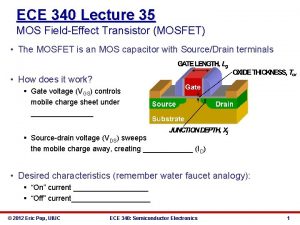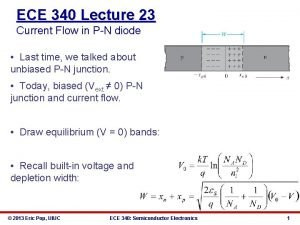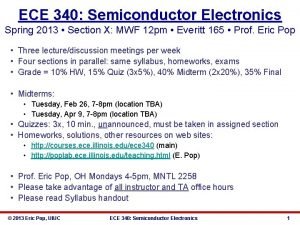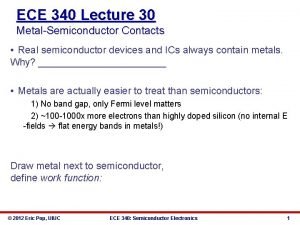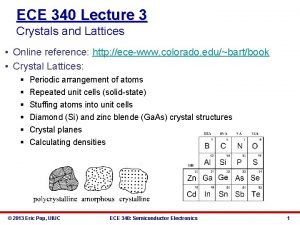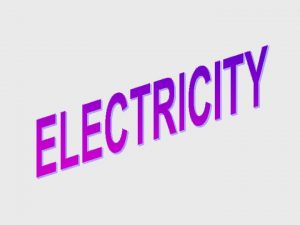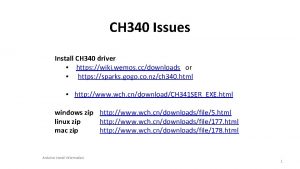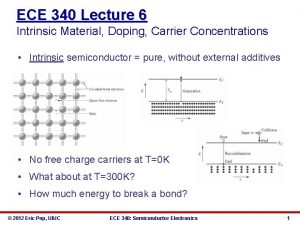ECE 340 Lecture 23 Current Flow in PN


















- Slides: 18

ECE 340 Lecture 23 Current Flow in P-N diode • Last time, we talked about unbiased P-N junction. • Today, biased (Vext ≠ 0) P-N junction and current flow. • Draw equilibrium (V = 0) bands: • Recall built-in voltage and depletion width: © 2013 Eric Pop, UIUC ECE 340: Semiconductor Electronics 1

• Qualitative band diagrams with applied voltage: • Current flow in equilibrium (V = 0): © 2013 Eric Pop, UIUC ECE 340: Semiconductor Electronics 2

• Qualitative current flow: © 2013 Eric Pop, UIUC ECE 340: Semiconductor Electronics 3

• Qualitatively expect I-V curve to be: • In forward bias, inside space charge region (SCR): • Where V is the applied bias and __________ © 2013 Eric Pop, UIUC ECE 340: Semiconductor Electronics 4

• Let’s look at the injected minority carriers: • On the n-side, injected holes. • Just at the edge of nside depletion region: © 2013 Eric Pop, UIUC ECE 340: Semiconductor Electronics 5

• Excess injected holes diffuse into the n-side: (same is true of excess injected electrons on p-side). • Injected hole diffusion current: • Where equilibrium hole concentration pn 0 = (and similar for injected electron diffusion on p-side, just replace subscripts p with n) • Hole diffusion current proportional to excess hole concentration at any distance x into the n-type region. • Due to hole current continuity, we can evaluate at x=xn 0=0 © 2013 Eric Pop, UIUC ECE 340: Semiconductor Electronics 6

• We can also write diffusion current for electrons in p-side: • Now total current © 2013 Eric Pop, UIUC ECE 340: Semiconductor Electronics 7

ECE 340 Lectures 24 -26 P-N diode carrier injection; reverse bias & breakdown Recap diode bias diagrams: a) equilibrium b) forward bias (V > 0) c) reverse bias (V < 0) © 2013 Eric Pop, UIUC ECE 340: Semiconductor Electronics 8

• Recap some of the equations: § Depletion width (decreases at forward bias, increases at reverse bias) § Maximum electric field (decreases at forward bias, increases at reverse bias) § Built-in voltage § Charge stored © 2013 Eric Pop, UIUC ECE 340: Semiconductor Electronics 9

§ Current density (current I = J∙A) § What about an asymmetrically doped junction? Say, p side much more heavily doped (NA >> ND): • Remember, current is due to minority carrier injection • Typically p-n junctions in real life are made by counterdoping. E. g. start with p-type wafer and dope with ND only at the surface to obtain junction. Eqs. so far readily apply if • NA = net doping on p-side = (NA – ND)p-side • ND = net doping on n-side = (ND – NA)n-side © 2013 Eric Pop, UIUC ECE 340: Semiconductor Electronics 10

• Ex: a p-n junction has NA=1019 cm-3 and ND=1016 cm-3. The applied voltage is 0. 6 V. a) What are the minority carrier concentrations at the edges of the depletion region? b) What are the excess minority carrier concentrations? c) Sketch δn(x) on the p-side if recombination lifetime is 2 μs. © 2013 Eric Pop, UIUC ECE 340: Semiconductor Electronics 11

• Current continuity along junction length, JTOT = const. • As carriers recombine (deep into n- or p-side) the diffusion current is replaced by _______ • But, we were able to deduce current equation by simple diffusion arguments at the _________ where the E-field was just barely zero. © 2013 Eric Pop, UIUC ECE 340: Semiconductor Electronics 12

• Reverse bias: § Depletion region widens § E-field across depletion region _________ § Current is due only to minority carrier _______ across the junction § Current is supplied by EHP generation in the _________ (what if I change the temperature or turn on the light? ) § Recall, J 0 = © 2013 Eric Pop, UIUC ECE 340: Semiconductor Electronics 13

• Junction breakdown when E-field exceeds a critical value. If current continues increasing, then diode _______. © 2013 Eric Pop, UIUC ECE 340: Semiconductor Electronics 14

P-N junction breakdown (3 types) 1) Zener breakdown: § Dominant for heavily doped (>1018 cm-3) p+n+ diodes § Breakdown at a few Volts (typically < 5 V) § Electron tunneling from filled valence states on p-side into (mostly) empty conduction band states on n-side © 2013 Eric Pop, UIUC ECE 340: Semiconductor Electronics 15

2) Avalanche breakdown § More lightly doped junctions (<1017 cm-3) § Wider depletion region, electrons accelerated across it gain enough energy to create additional EHPs § Impact ionization and carrier multiplication © 2013 Eric Pop, UIUC ECE 340: Semiconductor Electronics 16

• Empirical observation of VBR with doping and material § VBR decreases with increasing N (=NA or ND) § VBR decreases with decreasing EG • Breakdown dependence on temperature: § For tunneling (Zener) breakdown… § For avalanche breakdown… © 2013 Eric Pop, UIUC ECE 340: Semiconductor Electronics 17

3) Punchthrough breakdown: § Occurs when either depletion region “punches through” the entire length of the diode, e. g. xn(V) = Ln Ln © 2013 Eric Pop, UIUC ECE 340: Semiconductor Electronics 18
 38 mos
38 mos Ece 340
Ece 340 Uiuc ece 340
Uiuc ece 340 Ece 340
Ece 340 Ece 340
Ece 340 Ece 340 uiuc
Ece 340 uiuc 01:640:244 lecture notes - lecture 15: plat, idah, farad
01:640:244 lecture notes - lecture 15: plat, idah, farad A balanced delta connected load having an impedance 20-j15
A balanced delta connected load having an impedance 20-j15 Line current and phase current
Line current and phase current N=nc exp(-eg/2kt)
N=nc exp(-eg/2kt) Ac systems lesson 4
Ac systems lesson 4 Drift current and diffusion current in semiconductor
Drift current and diffusion current in semiconductor Intrinsic semiconductor
Intrinsic semiconductor In this figure
In this figure Delta to wye conversion balanced
Delta to wye conversion balanced Holding current and latching current
Holding current and latching current Diffusion current density
Diffusion current density Chapter 3 shielded metal arc welding
Chapter 3 shielded metal arc welding Touch current vs leakage current
Touch current vs leakage current

